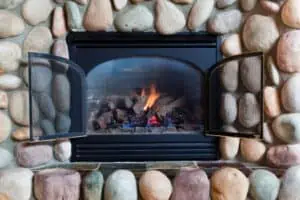How to Repair Brick Fireplace Components?
Fireplaces are a common fixture in homes both inside and outside, providing a place to heat the house with wood, coal, or other fuel. They also feature a number of components, including the firebox, damper, and chimney thimble. These components need to be maintained and repaired periodically, as needed, to ensure the safety and efficiency of the fireplace.
(Looking for a”fireplace gas insert repair“? Contact us Today!)

Clean-out door for the chimney:
When you open a fireplace, debris, ash, and other materials fall down the flue and must be cleared out regularly. This can be done as a DIY project or by calling a chimney company.
You can use a hammer drill and masonry bit to bore holes into the surrounding brick to create the clean-out opening, which is about eight inches wide and 12 inches tall above the flue base. Then you can insert a new clean-out door into the chimney opening.
Measure the area where you want to make the clean-out door. This will give you a precise measurement of the size of the frame you need to use. Once you’ve measured the area, cut out a piece of wood that will serve as a frame for your clean-out door.
Drill a hole on each side of the clean-out door frame, 1 inch from the corner, with a 1/2-inch-diameter masonry bit and a hammer drill. Then you can insert the cleanout door into the chimney opening and secure it with mortar mix.
Tuckpointing:
If there is loose or crumbly mortar on the outside of your firebox, you can repair it using tuckpointing. This process removes the deteriorated mortar joints, cleans them up, and applies fresh refractory cement.
It is important to have this done every year or two, whichever comes first. Tuckpointing can improve the strength of your firebox, prevent leaks and extend the life of the bricks.
Tuckpointing can be done by a professional, but it is not a difficult DIY project if you have the right tools and experience. To begin, a joint raker will help you scrape away loose, weak, or crumbly mortar, leaving good material in place. You can also use a hammer and masonry chisel to chip away mortar between the bricks.
During this process, you can also check the tuckpoint to ensure that it is solid and properly aligned. If the tuckpoint is too thin, it could allow water to seep into the bricks.
The tuckpoint should be slightly concave and recessed from the surface of the brick. Afterward, you can apply the refractory cement to fill in the cracks and seal the tuckpoint.
Masonry repairs:
If your masonry is in need of some major work, it may be time to call in an expert. This is especially true if you are dealing with a large brick wall or other significant masonry structure. A professional will be able to fix any problems that may arise during the masonry repair process, making sure that your home’s structural integrity is not compromised.
Re-caulk:
If there are any gaps around the edges of your cleanout door that could allow water to seep into the chimney, you can re-caulk them with silicon caulk. This is a more effective method than applying regular mortar. However, you will need to wait a few hours for the caulk to set, so pick a day that is warm and dry.

